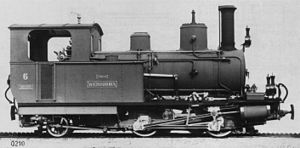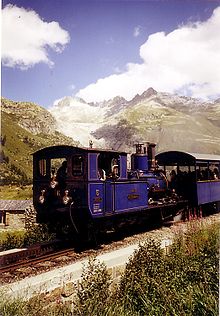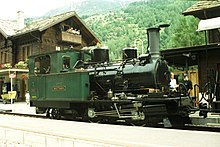VZ HG 2/3
| Visp-Zermatt-Bahn HG 2/3 | |
|---|---|
|
HG 2/3 No. 6, SLM company photo from 1902
|
|
| Numbering: | 1-8 |
| Number: | 8th |
| Manufacturer: | SLM |
| Year of construction (s): | 1890 (No. 1–4) 1893 No. 5) 1902 (No. 6) 1906 (No. 7) 1908 (No. 8) |
| Retirement: | 1929 (No. 1–5) 1935 (No. 8) 1941 (No. 6) |
| Type : | B1 'zz n2 (n4) (No. 2, 3, 5–8 later superheated steam) |
| Gauge : | 1000 mm ( meter gauge ) |
| Length over buffers: | 7,724 mm |
| Height: | 3,500 mm |
| Width: | 2,600 mm |
| Fixed wheelbase: | 1,960 mm |
| Total wheelbase: | 4,300 mm |
| Empty mass: | 23.5 t (No. 1–6) 24.6 t (No. 7–8) With superheater 0.4 t more each |
| Service mass: | 29.0 t (No. 1–6) 30.7 t (No. 7–8) With superheater, each 1.0 t more |
| Friction mass: | 20.6 t (No. 1–6) 22.3 t (No. 7–8) With superheater 0.4 t more each |
| Top speed: | 25 km / h (adhesion) 10 km / h (gear) DFB: 30 km / h (adhesion) 12 km / h (gear) |
| Driving wheel diameter: | 900 mm |
| Impeller diameter: | 600 mm |
| Gear system : | Abbot , two-lamellar |
| Number of drive gears: | 2 |
| Size gears: | 688 mm |
| Control type : | Walschaert / Belpaire |
| Number of cylinders: | 2 adhesion, 2 gear |
| Cylinder diameter: | 320 mm |
| Piston stroke: | 450 mm |
| Cylinder d. Gear drive: | 360 mm |
| Piston stroke gear drive: | 450 mm |
| Boiler overpressure: | 12 atü |
| Number of heating pipes: | 166 (wet steam) 92 (superheated steam) |
| Number of smoke tubes: | 10 |
| Heating pipe length: | 2,500 mm |
| Grate area: | 1.26 m² |
| Water supply: | 2,500 l |
| Fuel supply: | 1,300 kg (coal) |
| Brake: | Riggenbach counter pressure brake , suction air brake system Hardy, vapor brake (until 1902) |
| Coupling type: | Central buffer with screw coupling on both sides |
The steam locomotives of the type HG 2/3 formed the basis of operation on the Visp-Zermatt-Bahn from 1890 . Of the eight originally built by the Swiss Locomotive and Machine Works Winterthur, two locomotives on the Matterhorn-Gotthard Railway and the Furka Mountain Line steam railway have survived to this day.
construction

It was here during the construction phase to wet steam - tank locomotives with a combined drive for adhesion and rack operation with two driving axles and a trailing axle and two drive gears of the system Abt . Together with the series 97 cogwheel locomotives of the Erzbergbahn in Austria built by Floridsdorf in Vienna, which were also delivered in 1890 , these were the first locomotives with this drive system. The locomotives had an outer frame in order to get enough space for the gear drive. This consisted of a separately mounted and spring-loaded frame which accommodated the two drive gears that were coupled to one another. The gears were driven by two cylinders arranged under the boiler, while the cylinders for adhesion operation were arranged on the outside. All cylinders were inclined in a ratio of 1: 8 and had flat slides. In contrast to later cogwheel locomotives such as the HG 3/4 of the Furka-Oberalp-Bahn from 1914, the cylinders on rack sections did not work with a composite effect , i.e. H. all cylinders took their steam directly from the boiler. Although this resulted in high steam consumption, this disadvantage was viewed as negligible in view of the comparatively short rack sections between Visp and Zermatt. The control was based on the Heusinger system in a form modified by Belpaire , in which the drive was not via eccentrics , but via cross shafts from the drive linkage of the other side of the locomotive.
The boiler was designed in a conventional design with 166 heating pipes and arranged horizontally on the frame. It had a steam and sand dome as well as two safety valves of the Ramsbottom type . The water tanks with a total capacity of 2,500 liters were arranged on both sides of the boiler, the coal supply of 1.3 tons was carried at the rear of the driver's cab. The locomotives initially had four independent brake systems. The most important system was the Riggenbach type counter-pressure brake , which acted jointly, but independently of one another, on the gear and adhesion drive. In addition, there was a Hardy type suction air brake , which acted on the locomotive's driving axles and served to brake the train. A vapor barrier was also initially available, but was expanded until 1902, as vacuum and counter-pressure brakes were considered sufficient. As a parking brake, there were also a total of three hand brakes that acted on the drive wheels and both drive gears.
history
The first four locomotives arrived in 1890 on the not yet completed Visp-Zermatt Railway. The locomotives proved themselves very well, so that by 1908 a total of four more copies were procured, which differed only in details from the first series. The locomotives were given the chronological numbers from 1 to 8 and were also christened with the names of mountains around Zermatt. Since the VZ had no turntables , the locomotives were always on the train with the boiler in the direction of Zermatt.
Numerous details have been rebuilt or improved over the years. Already in 1893 all axles had to be replaced after an axle breakage, in 1894 new vacuum braking systems were installed, and at the same time the electric train lighting was introduced using accumulators. From 1901, Langer-type smoke burners were installed in most locomotives. The biggest improvement, however, was the conversion to superheated steam , which was carried out on six machines between 1913 and 1926 and enabled coal savings of up to 18%.
The electrification of the VZ with single-phase alternating current in 1929 made it possible to shut down the five oldest locomotives, three of which were initially retained as reserves. In 1935, locomotive no.8 was taken out of service, six years later locomotive no.6 came to a chemical company near Domat / Ems , today's Ems-Chemie . There the gear drive was removed and the locomotive was used in shunting operations. In 1961 it was turned off and given as a gift to the city of Chur , which set it up in front of a school. From there it was brought to the nascent Furka Mountain Line (DFB) steam railway in 1988 , which the Oswald-Steam company in Saturdayern had to work on. For this purpose, SLM manufactured a new gear drive according to the original plans. Commissioning at the DFB took place on August 27, 1989.
Locomotive No. 7 was kept as a reserve at the BVZ. For years it was the only traction vehicle that was independent of overhead contact lines and that could also run on rack sections. The locomotive was therefore mainly used in the construction of catenary lines and clearing snow, most recently after the Randa landslide in 1991. It also ran regularly in the BVZ's nostalgic traffic. For this purpose, the locomotive received a new boiler with light oil firing from the DLM in 2001 . Together with three restored historic passenger cars and a summer car , it was used several times a year on the Matterhorn-Gotthard railway network . In addition to the special trains from Brig to Zermatt, trips on the former FO route to Oberwald were offered. In the summer of 2002 it was used together with the sister locomotive No. 6 on the Furka mountain route, but lagged behind its performance. In the summer of 2010 it was finally loaned to the DFB and owned in 2018, but was only used occasionally due to the different requirements of the light oil company.
| No. | Surname | Serial number | Construction year | Conversion to superheated steam | Extent | Remarks |
|---|---|---|---|---|---|---|
| 1 | Matterhorn | 609 | 1890 | - | 1929 | |
| 2 | Monte Rosa | 610 | 1890 | 1913 | 1929 | |
| 3 | Mischabel | 611 | 1890 | 1926 | 1929 | |
| 4th | Gornergrat | 612 | 1890 | - | 1929 | |
| 5 | St. Theodule | 796 | 1893 | 1916 | 1929 | |
| 6th | Weisshorn | 1410 | 1902 | 1925 | 1941 | 1941 to Ems-Chemie , 1961 to the city of Chur , 1988 donation from the Chur school youth to the DFB |
| 7th | Breithorn | 1725 | 1906 | 1921 | 2001 new boiler, operational museum vehicle, from 2010 on loan from DFB, property DFB since 2018 | |
| 8th | Lyskamm | 1947 | 1908 | 1915 | 1935 |
literature
- Theo Stolz, Dieter Schopfer: Brig-Visp-Zermatt. History and rolling stock. Wabern, Zurich 1983, ISBN 3-907976-00-2 .
- Wolfgang Finke, Hans Schweers: The vehicles of the Furka-Oberalp-Bahn 1913-1999 . Brig – Furka – Disentis. Schöllenenbahn. Furka-Oberalp Railway. Schweers + Wall, Aachen 1999, ISBN 978-3-89494-111-6 .



